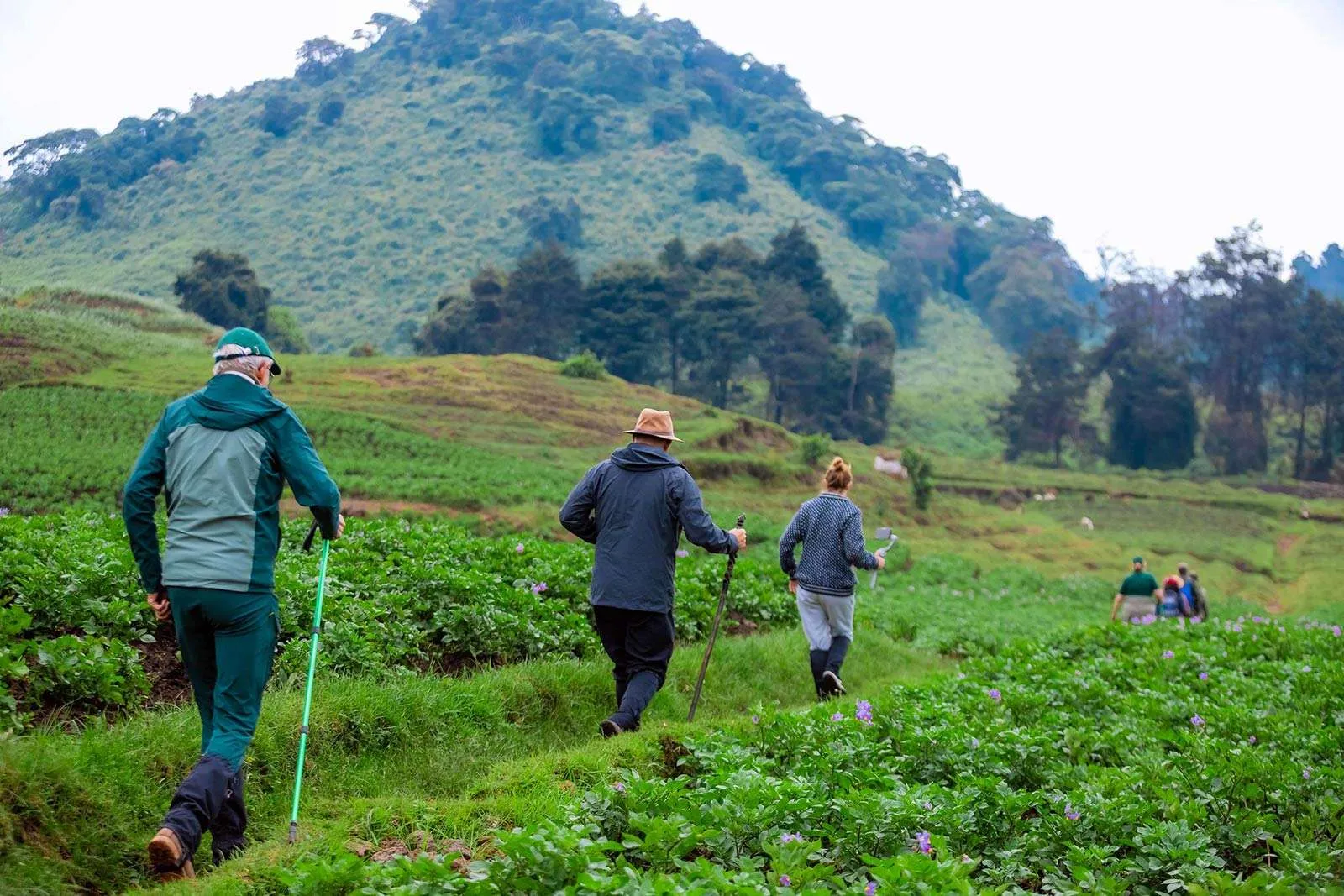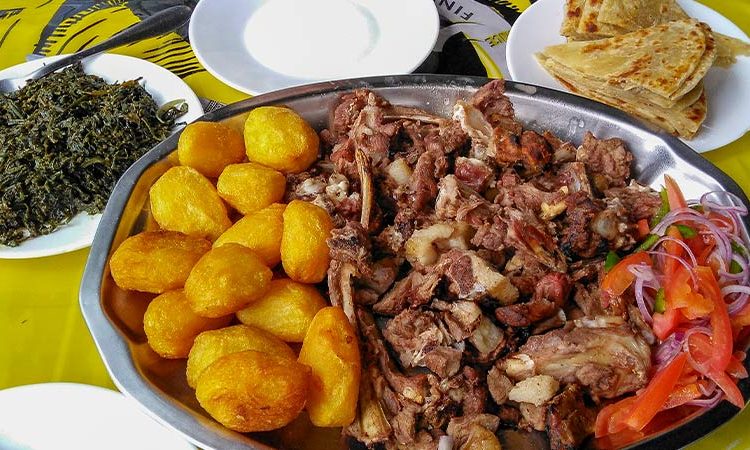- GET IN TOUCH WITH US:
- +256 753518160
- +256 777842166
- info@experiyatourcompany.com

What’s unique about Nyungwe National Park?
November 13, 2025
Is Lake Kivu good for swimming?
November 13, 2025Can I Go Hiking in Volcanoes National Park?
Volcanoes National Park in Rwanda is world-famous for its mountain gorillas, but beyond the mist-covered slopes and ancient bamboo forests lies another incredible adventure: hiking. Many travelers wonder, Can I go hiking in Volcanoes National Park? The answer is a resounding yes. In fact, Volcanoes National Park offers some of the most breathtaking and meaningful hiking experiences in East Africa, ranging from scenic nature walks to challenging volcanic summits and cultural heritage trails.
This detailed blog explores everything you need to know about hiking in Volcanoes National Park—available trails, requirements, difficulty levels, wildlife encounters, best times to visit, and tips for having an unforgettable adventure.
Volcanoes National Park: A Land of Fire, Mist, and Mountains
Located in Rwanda’s Northwestern region, Volcanoes National Park is part of the larger Virunga Massif—a chain of eight volcanoes rising dramatically along the borders of Rwanda, Uganda, and the Democratic Republic of Congo. Five of these volcanoes lie on the Rwandan side:
Karisimbi
Bisoke
Sabinyo
Gahinga
Muhabura
These towering peaks, combined with dense forests, crater lakes, rare wildlife, and cool mountain air, make Volcanoes National Park a hiker’s paradise. Whether you’re a seasoned mountaineer or a beginner seeking scenic nature experiences, the park offers something for every traveler.
Yes, You Can Hike in Volcanoes National Park
Hiking is allowed and widely encouraged in Volcanoes National Park. Rwanda Development Board (RDB) offers several guided hikes, each led by experienced park rangers. These hikes provide opportunities to explore:
Lush bamboo forests
Alpine meadows
Crater lakes
Volcanic summits
Gorilla habitats
Golden monkey zones
Historic sites linked to Dian Fossey
Each hike offers a different perspective on the park’s landscapes and ecological beauty.
The Most Popular Hiking Trails in Volcanoes National Park
1. Mount Bisoke Crater Lake Hike
Difficulty: Moderate to challenging
Duration: 5–7 hours
Altitude: 3,711 meters
Highlight: Stunning crater lake at the summit
Mount Bisoke is one of the most popular hikes in Volcanoes National Park. The trail begins at the base of the mountain and climbs steadily through:
Farmlands
Dense bamboo zones
Lush subalpine vegetation
As you ascend, the views become more dramatic, eventually leading you to the breathtaking crater lake at the summit. The crater is perfectly round, filled with still, blue-green water, and surrounded by misty mountain winds—a sight that makes the hike well worth the effort.
2. Mount Karisimbi Two-Day Summit Hike
Difficulty: Challenging
Duration: 2 days
Altitude: 4,507 meters
Highlight: Highest peak in the Virunga Mountains
Mount Karisimbi is the tallest volcano in the Virunga range and the 11th highest mountain in Africa. This hike is physically demanding and requires good fitness. It takes two days, with an overnight camp at around 3,700 meters.
The reward? Reaching the summit above the clouds, witnessing spectacular sunrise views, and experiencing one of Africa’s most dramatic volcanic landscapes.
3. Dian Fossey Tomb Hike
Difficulty: Moderate
Duration: 3–4 hours
Highlight: Historical site of primatologist Dian Fossey
This hike takes you to the former research camp of Dian Fossey, the legendary gorilla conservationist who dedicated her life to protecting mountain gorillas. The trail passes through mossy forests, old stone structures, and scenic pathways.
At the end of the hike, you reach:
Dian Fossey’s gravesite
The burial place of her favorite gorilla, Digit
Remains of the Karisoke Research Center
The hike is not only beautiful but emotionally powerful, connecting travelers to Rwanda’s conservation history.
4. Mount Muhabura Hike
Difficulty: Challenging
Duration: 8–10 hours
Altitude: 4,127 meters
Highlight: Panoramic views of Rwanda and Uganda
Mount Muhabura (also spelled Muhavura) is the second-highest volcano in Rwanda and offers spectacular views from the summit. The trail is steep and direct, requiring determination.
At the summit, you’re rewarded with:
A small crater lake
360-degree views of the Virunga volcano chain
Endless hills stretching into Rwanda and Uganda
This hike is perfect for experienced hikers.
5. Mount Gahinga Hike
Difficulty: Easy to moderate
Duration: 4–6 hours
Altitude: 3,474 meters
Highlight: Alpine marshlands and bamboo forests
Mount Gahinga offers a gentler hiking experience and is ideal for beginners or travelers who want a scenic but less strenuous trail. The trail passes through golden monkey habitats and bamboo zones before reaching the summit marshland.
6. Sabinyo Volcano Hike (Uganda Side, Seen from Rwanda)
While Sabinyo cannot be hiked from the Rwanda side, many hikers staying in Rwanda cross into Uganda to hike this dramatic, deeply eroded volcano. Known for its rugged peaks, Sabinyo’s summit sits at the meeting point of three countries—Rwanda, Uganda, and DRC.
7. Nature Walks and Cultural Trails
Volcanoes National Park also offers shorter, more relaxed walks, including:
Buhanga Sacred Forest Walk
Village nature trails
Birding walks
Cave visits (e.g., Musanze Caves)
These hikes offer cultural insights, botanical discoveries, and peaceful forest experiences.
What Makes Hiking in Volcanoes National Park Unique?
1. Stunning Volcanic Landscapes
The Virunga Mountains are among the most dramatic volcanic ranges in the world. Hiking here means:
Jagged volcanic peaks
Crater lakes
Views over three countries
Rolling green hills
Misty forests
Few hiking destinations offer such raw volcanic beauty.
2. Ancient Mountain Forests
The forests surrounding the volcanoes are thick, mysterious, and ancient. They host towering hagenia trees, dense bamboo, moss-covered rocks, giant lobelias, and rare alpine plants.
3. Incredible Wildlife
While hiking, you may encounter:
Golden monkeys
Colobus monkeys
Bushbucks
Rare birds
Butterflies
Mountain gorilla footprints or nests
Though gorilla trekking requires a separate permit, the ecosystem overlaps.
4. Cool Climate and Fresh Mountain Air
The park sits at high altitude, which gives it a refreshing climate ideal for hiking.
5. Deep Cultural Significance
The region is home to rich cultural traditions, especially from communities living around the volcanoes. Their stories, songs, and farming lifestyles add depth to the hiking experience.
Do You Need a Permit to Hike in Volcanoes National Park?
Yes, all hikes require a permit from the Rwanda Development Board. Permit fees vary depending on the hike. Unlike gorilla trekking, hiking permits are affordable and more easily available.
Is Hiking Safe in Volcanoes National Park?
Absolutely. Hiking in Volcanoes National Park is well-regulated and entirely safe. Every trail is guided by armed rangers who ensure:
Visitor safety
Animal protection
Navigation through thick forests
Emergency assistance if needed
Rwanda is considered one of Africa’s safest countries for outdoor adventures.
What to Wear and Bring for Hiking
Sturdy hiking boots
Warm layers (it can get cold)
Rain jacket
Long pants
Energy snacks
Plenty of water
Walking stick (available at the trailhead)
Gloves for steep trails
A hat or headband
Volcano slopes can be muddy, especially during the rainy season—proper gear enhances comfort.
Best Time for Hiking in Volcanoes National Park
Hiking is possible year-round, but the best seasons include:
Dry Season
June to September
December to February
These months offer clearer views, easier trails, and lower rainfall.
Wet Season
March to May
October to November
Trails become slippery but very lush and beautifully green.
How Long Should You Spend in Volcanoes National Park?
To fully enjoy hiking, plan:
1 day for easier hikes
2 days for medium hikes
3–4 days if combining summits and cultural experiences
Many travelers extend their stay to include gorilla trekking or golden monkey tracking.
Book Your Volcanoes National Park Hiking Experience with Experiya Tour Company
For an unforgettable hiking adventure in Volcanoes National Park, it’s essential to have expert guidance, reliable transportation, proper timing, and help securing the right permits. Experiya Tour Company specializes in organized hiking tours throughout the Virunga region. Their experienced guides take care of all logistics, from hiking permits and trail selections to transport, lodging, and park coordination. Whether you want to conquer Mount Bisoke, summit Karisimbi, explore Dian Fossey’s research site, or enjoy scenic nature walks, Experiya Tour Company ensures a seamless, safe, and enriching experience.




